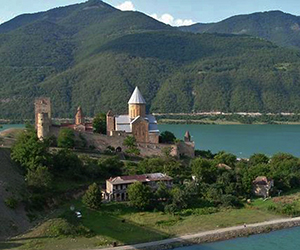Ananuri Fortress

Ananuri Fortress was the residence of the Georgian feudal lords. It is a Georgian architectural monument of the 16th-17th centuries. It had emergency living quarters in its towers; hence, it had more features of a palace rather than just a fortress or a castle.
At some point, Ananuri Fort was considered not only the center of Saeristavo but also the central fortification of the entire country.
The Ananuri Fortress complex formed gradually. It consisted of a citadel and a lower fortification. The citadel housed public, military, and religious buildings. Among them, the oldest is the Khevsurtei-type five-story tower. It is located in the middle of the citadel and has a pyramid-shaped roof (no later than the 16th century). In the eastern part of the citadel, there is a single-nave church (dating from the end of the 16th or early 17th century) known locally as the "Church of the Healer." Near its roofing, there is an alcove of the bell tower (the 17th century). Inside the citadel, there is a small nave church called Ghvtaeba (deity/goddess) (mid-17th century).
The main structure of the ensemble is the grand church of the "Mother of God." It almost leans on the Khevsureti Tover near the west wall. The intricate carvings on the facade of the church are richly detailed, however, there are some artificial and eclectic elements to the decorations. Some details disagree with the architectural forms. On the facades, there are plenty reliefs of the people and animals. From the long inscription on the south wall, it is known that the church was built in 1689 under the directive of Bardzim Msajultukhutsesi (Duke). The construction was supervised by Kaikhosro Baghsarashvili. The main tower of the citadel is located in the middle of the west wall, i. e. in the highest point of the whole ensemble. It is a seven-story square-shaped tower called Sheupovari (relentless) that has stairs along the wall. A building that serves as a water reservoir is located on the left-hand side of the entrance, adjacent to the wall. There is also a spring inside the premises.
Literature: ბერიძე ვ., XVI – XVIII საუკუნეების ქართული ხუროთმოძღვრება, ტ. 1, თბ., 1983; ზაქარაია პ., საქართველოს ძველი ციხესიმაგრეები, თბ., 1988.


